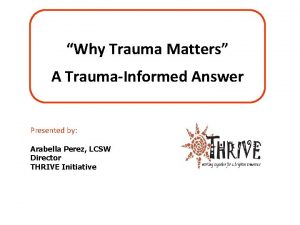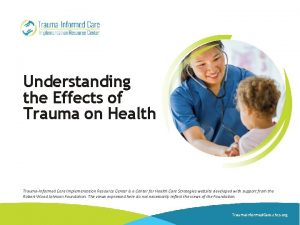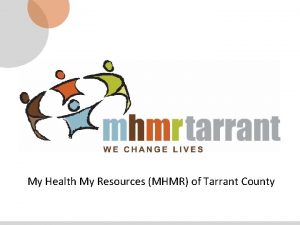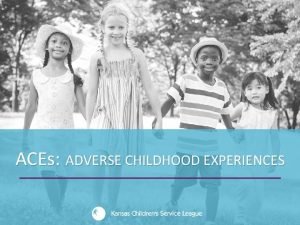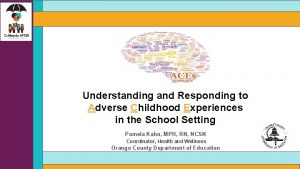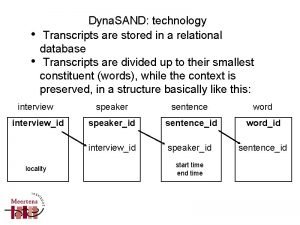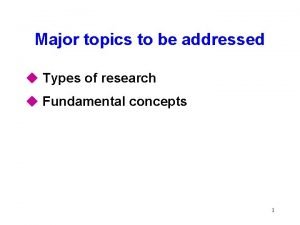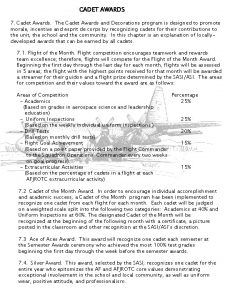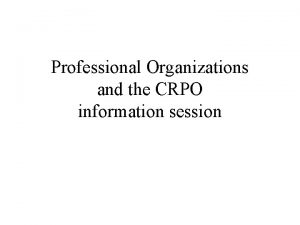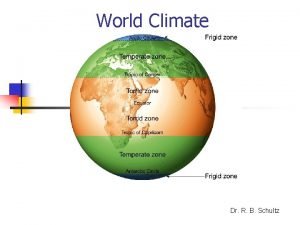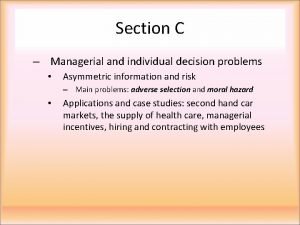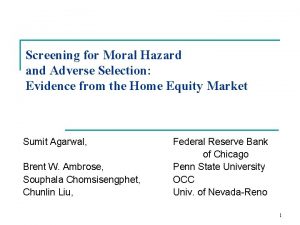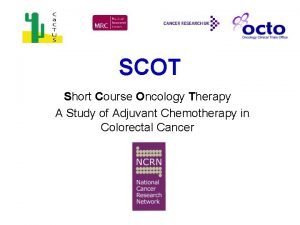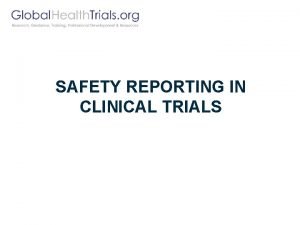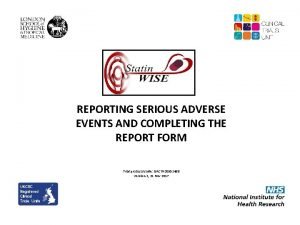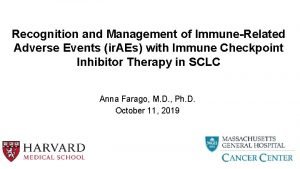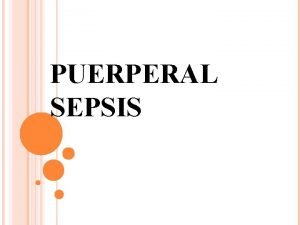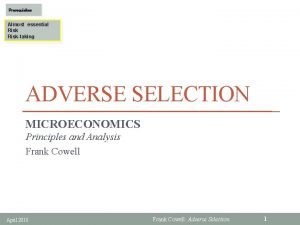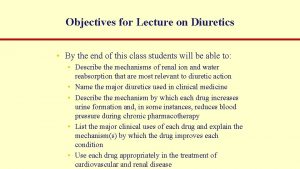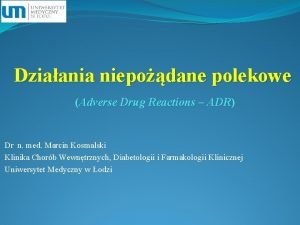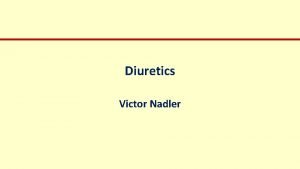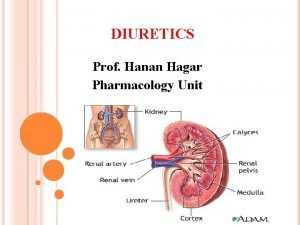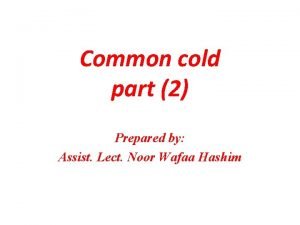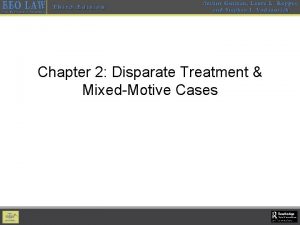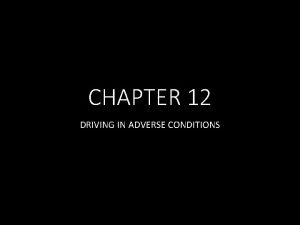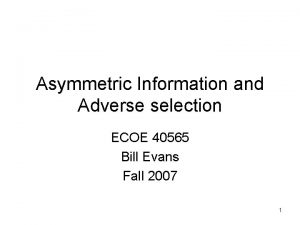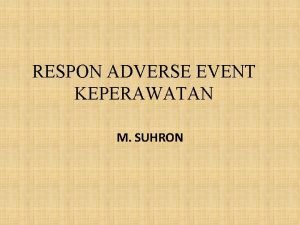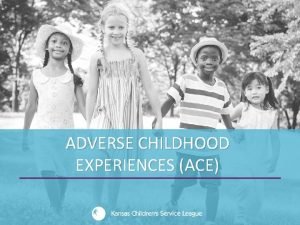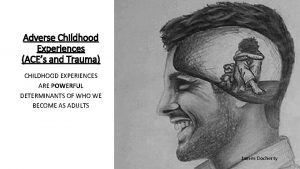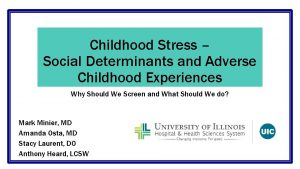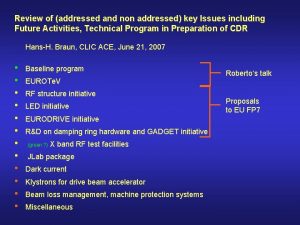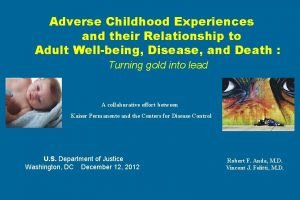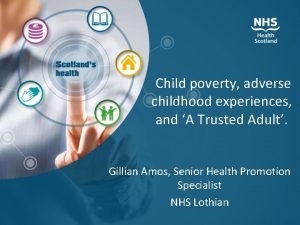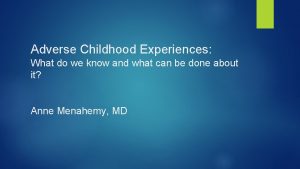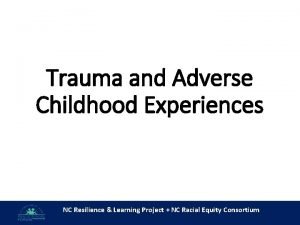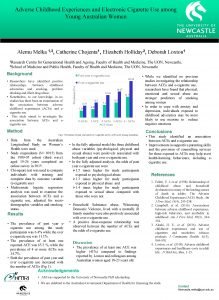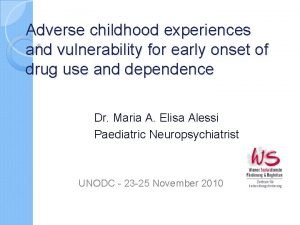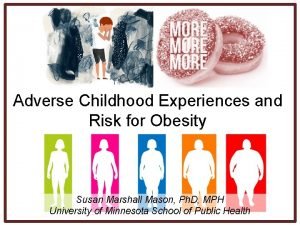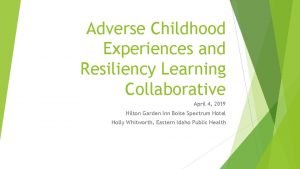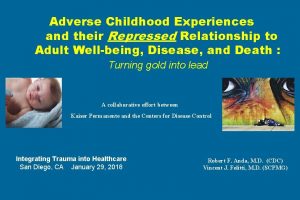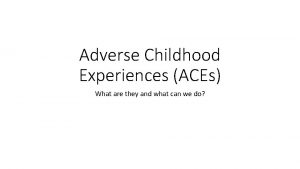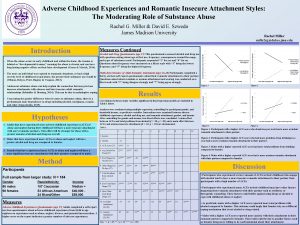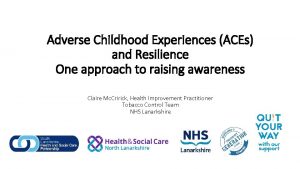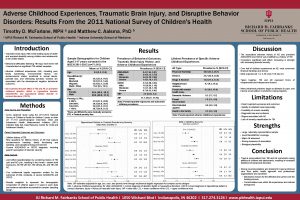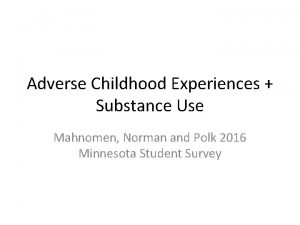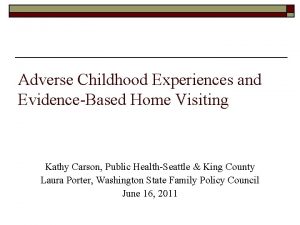Adverse Childhood Experiences Recognized and Addressed in Family













































- Slides: 45

Adverse Childhood Experiences: Recognized and Addressed in Family Law Lisa S. Negrini, LCSW Family Study Center USF St. Petersburg September 16, 2016

• VIDEO- The Children of Divorce Poem-3: 17 minutes- https: //www. youtube. com/watch? v=-0 N--LVbg 64&sns=em 9: 00 – 9: 10 Welcome- Judge Jack Helinger • VIDEO-Mrs. Doubtfire-1: 36 - http: //www. youtube. com/watch? v=N 6 w. X 14 k. F 7 g. U&sns=em 9: 10 – 9: 45 Introduction-Child’s Perspective- Lela Bloodsworth, LMHC • Video-Children and Divorce: The Facts https: //www. youtube. com/watch? v=Sn. NFW 3 IIvcc 9: 45 – 10: 00 ACE test (Personal & pending/closed case)- Facilitated by Lisa • VIDEO- Little Girl- 2: 54 minutes- http: //youtu. be/vm 0 UNn 7 t. J 5 o 10: 00 – 10: 30 Introduction to the Effects of ACEs and Trauma throughout the Lifespan- Lisa Negrini, LCSW • VIDEO- ACE’s-NBH-16: 02 minutes- https: //www. youtube. com/watch? v=95 ov. IJ 3 ds. Nk 10: 30 – 10: 45 Break • VIDEO- Voice of the Child- 2: 37 mins- https: //m. youtube. com/watch? v=lb. TFZ 8 cv. Ho 4 10: 45 – 12: 00 ACEs in High Conflict Families & Family Court James P. Mc. Hale Ph. D. and Lisa S. Negrini, LCSW

Self Care During Training and Life • Remember that Taking Care of Yourself during this training is Important!! • 2/3’s of you have an ACE score of at least 1 and 87% of those have more than one! Source: ACE Study at http: //www. cdc. gov/ace/index. htm

Vicarious Trauma • How do we handle working with high needs, high conflict families, and being witness to human pain and struggling, family and child dysfunction, trauma and toxic stress?

The Importance of Self-Care Vicarious Trauma - Secondary Trauma - Compassion Fatigue - Burnout = Disturbed sleep, withdrawal, tension, intrusive thoughts, depression, difficulty concentrating, anger, exhaustion, physical illness, stress… Getting peer support, having a work-life balance, having a healthy lifestyle, seeking training, spending time with family and friends, consulting help when you need it

Why are we talking about ACE’s? We need to acknowledge Trauma and Toxic Stress as being highly influential in the ways that Parents parent and Family's function.

Being Trauma Informed Means: That you Presume- A Trauma History of all who appear before you -and that you consider trauma as the cause of the behavior before we start identifying other reasons for the behavior

Trauma Informed Courts are: • Informed about Trauma and Toxic Stress and thinking about ACE’s in every day work!

Defining Trauma and Toxic Stress • Acute Trauma = A single event- An emotional response to a single event in which terror and helplessness existed (death, rape, disaster…) • Chronic Trauma = Prolonged exposure, A series of events (child abuse, family violence. . ) • Complex Trauma = Exposure to severe and pervasive traumatic events, often of an invasive, interpersonal nature, and often occur in the context of the child’s relationship with a caregiver

Toxic Stress = Trauma • Toxic Stress = When exposed to prolonged stress and/or severe adversity, the persistent activation of the stress response system (Poverty, high conflict, homelessness, hunger, frequent losses, caregiver separations, parental depression, substance use, mental health issues, high tension, worry…) • Trauma is frequently experienced in a a family context and in a multi-generational and intergenerational way

Children Exposed to Violence • 24 percent of children have witnessed violence in their homes, schools, and communities in the past year • 38 percent during their lifetimes 2014 Nat. SCEV study


Domestic violence (verbal, emotional and physical) poses a serious long term threat to children's emotional, psychological, and physical well-being, particularly if the violence is chronic.

Exposure to DV causes…. . Exposure to domestic violence has also been linked to poor school performance. Children who grow up with domestic violence may have impaired ability to concentrate; difficulty in completing school work; and lower scores on measures of verbal, motor, and social skills. Physical health problems, Behavior problems in adolescence (e. g. , juvenile delinquency, alcohol, substance abuse), Emotional difficulties in adulthood (e. g. , depression, anxiety disorders, PTSD) Generalized anxiety, Sleeplessness, Nightmares, Difficulty concentrating, High activity levels, Increased aggression, Increased anxiety about being separated from a parent, Intense worry about their safety or the safety of a parent. Children may hear one parent/caregiver threaten the other, observe a parent who is out of control or reckless with anger, see one parent assault the other, or live with the aftermath of a violent assault. Many children are affected by hearing threats to the safety of their caregiver, regardless of whether it results in physical injury. Children who live with domestic violence are also at increased risk to become direct victims of child abuse. Children may learn that it is acceptable to exert control or relieve stress by using violence, or that violence is in some way linked to expressions of intimacy and affection. These lessons can have a powerful negative effect on children in social situations and relationships throughout childhood and in later life. Sleep and/or eating disruptions, Withdrawal/lack of responsiveness, Intense/pronounced separation anxiety, Inconsolable crying, Developmental regression, loss of acquired skills, Intense anxiety, worries, and/or new fears, Increased aggression and/or impulsive behavior, Nightmares, sleep disruptions, Aggression and difficulty with peer relationships in school, Difficulty with concentration and task completion in school, Withdrawal and/or emotional numbing, School avoidance and/or truancy……………. .

• • • Domestic violence High Conflict Families Separation Divorce Custody Fights Paternity arguments

In Family Law. The cases you see are evidence of ACE categories: • • • High Conflict and Dissolution Post Dissolution Domestic Violence Injunctions Paternity Custody by Extended Family Member

Red Flags of Trauma in Family Court CIRCUMSTANCES OF CASE: Domestic Violence, physical punishment LIVING CIRCUMSTANCE: Hazardous conditions, No Utilities, On the streets, In a shed, With Friends or Relative, In their car � STATUS: Runaway, jail, prison, mental health or substance abuse facility REPORTED HOTLINE HISTORY: A Parent’s childhood or Sibling’s history, Adopted? Permanent Guardianship/Relative Caregiver? , Sibling’s locations (jail, dead, mental health issues) INDICATED & UNFOUNDED REPORTS: Give them weight: unfounded doesn’t = untrue TYPES OF CHARGES AND FREQUENCY: Multi Batteries included on LEO or staff, Sex Offenses (a victim of child sex abuse? )

• SCHOOL HISTORY: Graduate from HS? , Suspensions & expulsions • DOMESTIC VIOLENCE: Victim or Offender • MENTAL HEALTH HISTORY: Age, Multi Diagnosis: ADHD, PTSD, Bi-polar, Anxiety, Explosive Disorder, Hospitalizations • MULTI-SEXUAL PARTNERS: Unknown Fathers? Children who were product of rape? • PHYSICAL APPEARANCE AND EMOTION: Aggressive, Antsy, No eye contact, Hunched, Exhausted • PHYSICAL HEALTH: Diabetes, Heart Disease, Cancer, Auto. Immune Diseases, Sores • DRUGS: Substance use despite counseling or intervention

Adverse Childhood Experiences (ACEs) Study -was one of the largest investigations ever conducted Purpose was to assess the relationship between early adversity and adult health (Kaiser Permanente- 1997) More than 60% of adults report experiencing abuse or other difficult family circumstances during childhood. National Center for Mental Health Promotion and Youth Violence Prevention

Trauma as a Public Health Issue • Dr. Nadine Burke-Harris: Ted Talk “How Childhood Trauma Effects Health across the Life Span” • https: //www. youtube. com/watch? v=95 ov. IJ 3 ds. Nk

ACE Study Effectively addressing and treating childhood trauma and toxic stress will reduce later health and social emotional problems throughout the life span

ACE Score • The CDC’s Adverse Childhood Experiences study uncovered a stunning link between childhood trauma and the chronic diseases people develop as adults, as well as social and emotional problems. This includes heart disease, lung cancer, diabetes and many autoimmune diseases, as well as depression, violence, being a victim of violence, and suicide. • Two thirds of the 17, 000 people in the ACE study had an ACE score of at least one – 87 percent of those had more than one!


People who have experienced trauma are: • • • 15 times more likely to attempt suicide 4 times more likely to become an alcoholic 4 times more likely to develop a sexually transmitted disease 4 times more likely to inject drugs 3 times more likely to use antidepressant medication 3 times more likely to be absent from work 3 times more likely to experience depression 3 times more likely to have serious job problems 2. 5 times more likely to smoke 2 times more likely to develop chronic obstructive pulmonary disease National Center for Mental Health Promotion and Youth Violence Prevention, "Childhood Trauma and Its Effect on Healthy Development, " (http: //sshs. promoteprevent. org/sites/default/files/trauma_brief_in_final. pdf)

Welcome Dr. James Mc. Hale

• What are our opportunities for transition to a more Trauma Informed Family Law Division?

What can the courts do? 1. Understand Trauma and Child development- Trainings and Conferences 2. Presume Trauma- Always 3. Coordinate all cases involving one family- One Family/One Judge Model 4. Set an expectation for trauma &child development- require child dev. and trauma info from all professionals 5. Read the case with a trauma lens- look for red flags and trauma events and signs of toxic stress

6. Order screening, assessment, and treatment - order evidence based screening, assessment and treatment 7. Hold all accountable- holding everyone who comes into contact with the child and family accountable 8. Be a convener- bring community partners together to address trauma 9. Monitor the data- review and analyze data, and adjust court practices 10. Take care of yourself- learn about vicarious trauma and take inventory of your balance www. flcourts. org/resources-and-services/court-improvement/judicial-toolkits/family-courttoolkit/court-implications. stml

Trauma-Informed Systems We need to develop a system that: • Has an understanding of the causes and effects of trauma and, • Has practices that correspond to that understanding

A Trauma-Informed System has: • Awareness • Screening and Assessment for Trauma • Trauma Specific Interventions • Collaborative efforts across systems

We need a comprehensive, trauma-informed approach to engaging and serving children and families that focuses on their capacity for RESILIENCE

What are other Courts doing nationally? • Training and Education on Trauma-involving all stakeholders • Developing a Trauma-Informed Child Task Force • Trauma screenings offered and available • Building capacity for Trauma-specific services • The use of Multidisciplinary teams • Addressing Secondary trauma and compassion fatigue Stark County Family Court Ohio and Legal Services for Children San Francisco

Remembering that Parents were children once…

Besides developing our system response, What else can we do to help buffer the negative impact of Adverse Childhood Experiences on children?

Building Resiliency - Positive relationships and interactions can restore children’s sense of safety and begin the healing process! Safety, Stability and Treatment!

Engaging the Family System • Bringing together all of the Child’s caregivers to engage and activate a strong coparenting alliance to support the child’s healing and recovery to an optimal level of functioning

Mental Health Treatment for Trauma and Toxic Stress is needed to build resiliency? Universal Screening leads to Assessment and Treatment which are critical for healing and repair

Recommended Trauma Treatment for Children and Parents: Child-Parent Psychotherapy (CPP)- Dyadic (childcaregiver) therapeutic intervention for children 0 -5 who have experienced trauma or toxic stress and their caregiver. Parent Child Interaction Therapy (PCIT)-Dyadic intervention for children 2 -8 who have behavioral issues. Trauma-Focused Cognitive Behavioral Therapy (TFCBT)-Dyadic intervention for children 3 -18 who have experienced trauma. Evidence Based Treatment should be recommended! The California Evidence-Based Clearinghouse www. cebc 4 cw. org

What is the most important Action Step that we can take to create a more traumainformed, responsive Family Law Division to reduce the effects of ACEs on children and families? Send more ideas to: lnegrini@usfsp. edu

Final Thoughts or Questions?

• • The USFSP Family Study Center www. usfsp. edu/fsc For Every Child, In Every Family System: Positive Coparenting Relationships Protect Children Identifying and working with the core group of significant adults in the child’s life challenges helping professionals, but is a challenge worth meeting Positive coparenting alliances improve parenting by the involved adults, minimize future abuse, and directly benefit the child The “all hands-on-deck” coparenting model is THE key to minimizing trauma and healing children. To stop falling short and to make the difference we continue to need to make for children, every agency must understand embrace such a model.

Resources for More Information • • • National Child Traumatic Stress Network- nctsn. org National Institute of Mental Health-nimh. nih. gov Florida Association for Infant Mental Healthfaimh. org/ Zero To Three- zerotothree. org Veterans Administration-ptsd. va. gov http: //www. nctsnet. org/trauma-types/medicaltrauma http: //www. nasmhpd. org/TA/NCTIC. aspx apa. org/topics/trauma www. usfsp. edu/fsc

Resources for Further Learning • “Charting the Bumpy Road of Coparenting” James Mc. Hale • “Coparenting: A Conceptual and Clinical Examination of Family Systems” James P. Mc. Hale, Kristin M. Lindahl • “Young Children & Trauma”- Joy Osofsky • “Children Exposed to Violence”- M. Feerick & G. Silverman • “An Integrated Approach of Childhood Exposure to Violence and Brain Development”- L. Chamberlain • “Don’t Hit My Mommy!”- Alicia Lieberman • “Ghosts & Angels: Intergenerational Patterns in the Transmission and Treatment of Traumatic Sequelae of Domestic Violence”- A. Lieberman • “Child Parent Relationship Therapy Treatment Manual”- Gary Landreth • “Treating Trauma & Traumatic Grief in Children”- Cohen, Mannarino & Deblinger • “Parent-Child Interaction Therapy”- T. Hembree-Kigin & C. Mc. Neil • “Handbook of Infant Mental Health”- C. H. Zeanah (Editor) • www. nctsn. org • www. childwitnesstoviolence. org

Great Web Resources… • Trauma Informed Child Welfare Practice Toolkit http: //www. chadwickcenter. org/CTISP/images/TICWPractice. Toolkit. pdf Trauma-sensitive schools http: //traumasensitiveschools. org/ Trauma aware schools http: //traumaawareschools. org/ Strategies to create a trauma-sensitive school http: //sspw. dpi. wi. gov/sspw_traumastrategies Incorporating trauma-sensitive practices into schools http: //sspw. dpi. wi. gov/sspw_traumaschlresources Language of trauma and loss lesson plans http: //westernreservepublicmedia. org/trauma/overview. htm Attending to Well-being in Child Welfare http: //cascw. umn. edu/wp-content/uploads/2014/04/CW 360_Spring 2014_WEB. pdf Harvard Center for the Developing Child www. developingchild. harvard. edu/

THANK YOU FOR PARTICIPATING IN OUR TRAINING!
 Adverse childhood experiences study
Adverse childhood experiences study Adverse childhood experiences study
Adverse childhood experiences study Mhmr of tarrant county
Mhmr of tarrant county Schoolsworkpro
Schoolsworkpro Slidetodoc.com
Slidetodoc.com Early childhood and middle childhood
Early childhood and middle childhood Eco friendly partially addressed mail
Eco friendly partially addressed mail Non programmed decision example
Non programmed decision example The third epistle of st. john is addressed to________.
The third epistle of st. john is addressed to________. Partially addressed mail
Partially addressed mail Essential elements of a contract
Essential elements of a contract Technology addressed
Technology addressed Topics to be addressed
Topics to be addressed Invoked audience
Invoked audience Recognized violation of cultural norms
Recognized violation of cultural norms To be recognized as an “ace of aces” a cadet must
To be recognized as an “ace of aces” a cadet must Crpo recognized programs
Crpo recognized programs Which company is recognized as the inventor of cruising
Which company is recognized as the inventor of cruising Which two types of polar climate are recognized?
Which two types of polar climate are recognized? Cultural deviant
Cultural deviant Sys.dm_db_index_physical_stats
Sys.dm_db_index_physical_stats Recognized seasonal employer visa
Recognized seasonal employer visa Adverse reaction definition
Adverse reaction definition Near miss examples ppt
Near miss examples ppt Adverse selection
Adverse selection Adverse selection
Adverse selection Adverse reaction definition
Adverse reaction definition Adverse reaction definition
Adverse reaction definition Adverse events in hospital
Adverse events in hospital Ir adverse event
Ir adverse event Puerperal sepsis
Puerperal sepsis What is adverse selection
What is adverse selection Paracetamol adverse effects
Paracetamol adverse effects Loop diuretics adverse effects
Loop diuretics adverse effects S
S Dpp4 inhibitor adverse effects
Dpp4 inhibitor adverse effects Adverse selection
Adverse selection Azalastyna
Azalastyna Loop diuretics adverse effects
Loop diuretics adverse effects Diuretic classification
Diuretic classification Hayanil tab
Hayanil tab Adverse treatment
Adverse treatment Adverse conditions light
Adverse conditions light Chapter 12 driving in adverse conditions
Chapter 12 driving in adverse conditions Adverse selection
Adverse selection Adverse event adalah
Adverse event adalah
